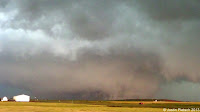

 On May 22, 2011, no one knew what was going to happen with the weather. Early in the morning, all the signs were pointing to a major severe weather outbreak somewhere in the Midwest. More importantly, everything was primed for an extended tornado outbreak. An early morning weather balloon launch from the Springfield, MO weather office indicated this as well.
On May 22, 2011, no one knew what was going to happen with the weather. Early in the morning, all the signs were pointing to a major severe weather outbreak somewhere in the Midwest. More importantly, everything was primed for an extended tornado outbreak. An early morning weather balloon launch from the Springfield, MO weather office indicated this as well. First, let me explain the 4 things SEVERE storms need to develop/survive. These kind of storms need instability, moisture, lift, and shear. For instability, there was plenty of CAPE (Convective Available Potential Energy), which is a term for the amount of gasoline in the atmosphere to fuel storms. Keep in mind that you don't need a whole lot of CAPE for severe storms (or any storms, for that matter) to develop. Think about a car. Even if there is just a little bit of gasoline in the tank, you will still be able to start the car and go somewhere. In addition, the early morning sounding showed a very nice veering profile, which means the winds were turning clockwise with height. Basically, winds that veer with height allow for storms that develop in that area to obtain rotating updrafts. This, in turn, provides excellent support for tornado development, because a tornado is simply a violently rotating updraft. Next, there was plenty of wind shear in this same profile, which would allow the storms that develop in this environment to become tilted. In other words, this would allow these storms to last for hours, as the updrafts and downdrafts would not be interfering with each other.
First, let me explain the 4 things SEVERE storms need to develop/survive. These kind of storms need instability, moisture, lift, and shear. For instability, there was plenty of CAPE (Convective Available Potential Energy), which is a term for the amount of gasoline in the atmosphere to fuel storms. Keep in mind that you don't need a whole lot of CAPE for severe storms (or any storms, for that matter) to develop. Think about a car. Even if there is just a little bit of gasoline in the tank, you will still be able to start the car and go somewhere. In addition, the early morning sounding showed a very nice veering profile, which means the winds were turning clockwise with height. Basically, winds that veer with height allow for storms that develop in that area to obtain rotating updrafts. This, in turn, provides excellent support for tornado development, because a tornado is simply a violently rotating updraft. Next, there was plenty of wind shear in this same profile, which would allow the storms that develop in this environment to become tilted. In other words, this would allow these storms to last for hours, as the updrafts and downdrafts would not be interfering with each other.
On a side note, an updraft is air that is moving upward at a very fast speed. This aids in storm development, and a downdraft comes from storms that are decaying. If these two things are interacting with each other in the same place in the storm, the storm will not be able to sustain itself.
Anyway, I have already mentioned two of the four things required for the development of severe storms. For the third item, we need some kind of lift to get the storms to fire off. This can come in the form of a front, outflow boundary (from previous storms), dryline, etc. In this case, there was a powerful cold front that plowed through on this day, and that acted as a lifting mechanism.
Moisture is the final ingredient needed to stroke a severe storm. To give you an idea of what I am talking about, think of when you watch the weather on TV every night. The meteorologist will often refer to the dew point and/or humidity. Both of these are ways to measure moisture, and storms thrive in high moisture environments.
Now that we have all these ingredients in one place, let's talk severe weather!!! The big event on May 22, 2011, happened in Joplin, MO. An EF-5 tornado rolled through and completely destroyed everything in its path. On the side of this post, I have included some radar images from the event. The images to the far left are the Radar Reflectivity, and the images to the right are Storm Relative Velocity, which is a measure of wind shear. From top to bottom, the time stamps are 5:29 PM, 5:43 PM, 5:48 PM, 5:53 PM, and 5:58 PM. Notice in the third image there is an area enclosed by a white circle labeled "debris." Well, that is an example of what the radar is detecting, and it is known as a debris ball. These occur with particularly destructive tornadoes. Want to know more about this devastating event? Please take a look at this link for a further synopsis of this event.































